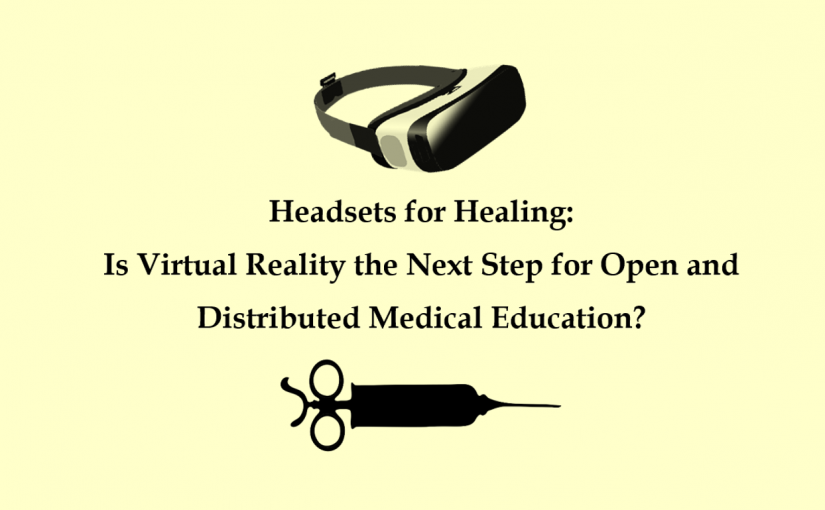References
Chandrasekera, T., & Yoon, S. Y. (2018). The Effect of Augmented and Virtual Reality Interfaces in the Creative Design Process. International Journal of Virtual and Augmented Reality, 2(1), 1–13. doi: 10.4018/ijvar.2018010101
Chen, B. Y., Kern, D. E., Kearns, R. M., Thomas, P. A., Hughes, M. T., & Tackett, S. (2019). From Modules to MOOCs: Application of the Six-Step Approach to Online Curriculum Development for Medical Education. Academic Medicine, 94(5), 678–685. doi: 10.1097/acm.0000000000002580
Dyer, E., Swartzlander, B. J., & Gugliucci, M. R. (2018). Using virtual reality in medical education to teach empathy. Journal of the Medical Library Association, 106(4), 498–500. doi: 10.5195/jmla.2018.518
Fineman, B., & Lewis, N. (2018). Securing Your Reality: Addressing Security and Privacy in Virtual and Augmented Reality Applications. EduCause Review. Retrieved from https://er.educause.edu/articles/2018/5/securing-your-reality-addressing-security-and-privacy-in-virtual-and-augmented-reality-applications
Kuehn, B. M. (2018). Virtual and Augmented Reality Put a Twist on Medical Education. Jama, 319(8), 756–758. doi: 10.1001/jama.2017.20800
Liyanagunawardena, T. R., & Williams, S. A. (2014). Massive Open Online Courses on Health and Medicine: Review. Journal of Medical Internet Research, 16(8). doi: 10.2196/jmir.3439
Mercer, C. (2018). Medical students protest steadily rising tuition fees. Canadian Medical Association Journal, 190(39). doi: 10.1503/cmaj.109-5654
Moscova, M. (2019, November 11). Why virtual reality won’t replace cadavers in medical school. Retrieved from https://theconversation.com/why-virtual-reality-wont-replace-cadavers-in-medical-school-67448
Newman, C. (2018, December 21). Digital cadavers are replacing real ones. But should they? Retrieved from https://www.nationalgeographic.com/science/2018/12/digital-cadavers-are-replacing-real-ones-but-should-they-future-medicine/#close
Pantelidis, P., Chorti, A., Papagiouvanni, I., Paparoidamis, G., Drosos, C., Panagiotakopoulos, T., … Sideris, M. (2018). Virtual and Augmented Reality in Medical Education. Medical and Surgical Education – Past, Present and Future. doi: 10.5772/intechopen.71963
Queen’s University Launches Canada’s First VR Medical Training Centre. (2018, October 9). Retrieved from https://healthsci.queensu.ca/administration/announcements/queens-university-launches-canadas-first-vr-medical-training-centre
Riva, G. (2003). Applications of Virtual Environments in Medicine. Methods of Information in Medicine, 42(05), 524–534. doi: 10.1055/s-0038-1634379
Roston, B. A. (2016, January 11). Virtual reality headsets and glasses: when things get tricky. Slashgear. Retrieved from https://www.slashgear.com/virtual-reality-headsets-and-glasses-when-things-get-tricky-11422243/
Sattar, M. U., Palaniappan, S., Lokman, A., Shah, N., Khalid, U., & Hasan, R. (2020). Motivating Medical Students Using Virtual Reality Based Education. International Journal of Emerging Technologies in Learning (IJET), 15(02), 160. doi: 10.3991/ijet.v15i02.11394
Sayed, N., Rodrigues, C., Reedman, V., & Mcqueen, S. (2019). A Call to Action Against Rising Medical Student Tuition. University of Ottawa Journal of Medicine, 9(1), 28–32. doi: 10.18192/uojm.v9i1.3840
Featured Image Attribution: I created the featured image by editing and combining images by Pixaline and Gordon Johnson from Pixabay. The Pixabay license allows users to use, download, copy, modify and adapt all free content.
Navigation
- Introduction
- How is VR Currently Used in Medical Education?
- Students
- Ease of Use
- Cost
- Teaching
- Interaction
- Organizational Issues
- Novelty and Networking
- Security and Privacy
- Conclusion and Question
- References and Attribution
License
This work is licensed under Creative Commons (CC) Attribution 4.0 International

